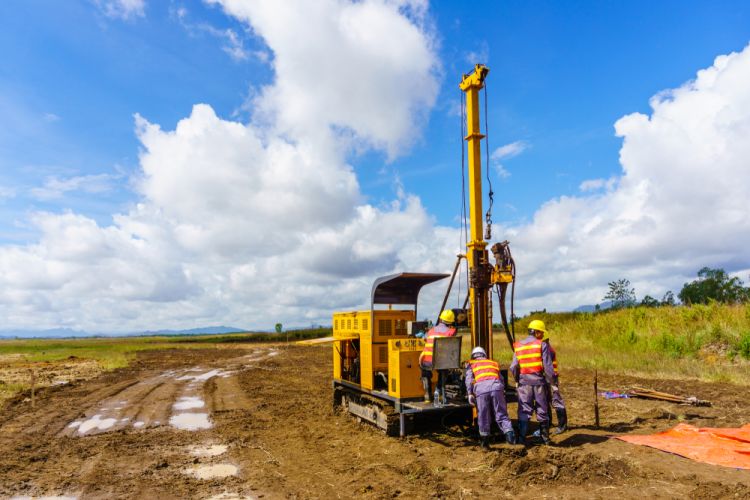Get This Report on Geotechnical Engineering For Construction Projects
Get This Report on Geotechnical Engineering For Construction Projects
Blog Article
What Does Geotechnical Engineering For Construction Projects Do?
Table of ContentsGeotechnical Engineering For Construction Projects for BeginnersGeotechnical Engineering For Construction Projects Fundamentals ExplainedExcitement About Geotechnical Engineering For Construction ProjectsGeotechnical Engineering For Construction Projects Can Be Fun For AnyoneGeotechnical Engineering For Construction Projects Fundamentals Explained
For that reason, during the investigation, it is essential to drill at the needed deepness and the needed number of openings as per the referral of the Canadian Foundation Design criterion. Occasionally, the proprietor could conserve some Geotechnical Examination expense however wind up investing more than the anticipated during the building and construction expense.The responsibilities of the geotechnical consultant include supplying material screening for building and construction support. Geotechnical Engineering for Construction Projects. Geotechnical engineers evaluate all the field test reports to ensure that construction is taking place as per the job spec. During building and construction, a confirmatory test for soil compaction is done on-site to make sure that no future negotiation takes place
After the concrete is put -7 days and 28 days- tests are performed on concrete examples collected from the site to make sure that the concrete put meets the design criterion. Asphalt core is taken after the Asphalt is laid and compacted to confirm that it fulfills the style standard. All lab test records are analysed by the Geotechnical Engineer to make certain that it fulfills the project spec.
The Ultimate Guide To Geotechnical Engineering For Construction Projects

Geotechnical design plays a crucial function in guaranteeing the security of building projects. Geotechnical engineering is a vital branch of civil design that focuses on understanding the practices of earth products, such as dirt and rock.

For a trustworthy structure and a smooth building procedure, depend give the know-how you need. Get in touch with to obtain expert advice and geotechnical solutions customized to your following project.
The Main Principles Of Geotechnical Engineering For Construction Projects
When embarking on a land advancement project, recognizing the ground under your feet is as crucial as the structures you prepare to develop over it. Our Geotechnical Engineering group evaluate the ground, guaranteeing it appropriates for the recommended development while offering you with the information required to fulfill your task goals.
Geotechnical Engineering checks out the formation of the ground, as it is the foundation for all projects. Where structures need to be designed with regard to the ground problems; ground conditions (e.g., soft ground) may need enhancing depending upon the dimension of the desired framework. Before building, you need to learn about the groundwater, dirt structure, and liquefaction likelihood of your land.
For websites that are not attached on the regional authority infrastructure added site investigations would certainly be needed to offer technical inputs for on-site stormwater and wastewater. We have actually experienced Geotechnical Engineers based in each office, supporting your geotechnical demands try this website nationwide. Get to out to us to talk about how we can sustain your following job.
These reports are customized to meet the certain requirements of a task and include layout criteria and guidance for the building and construction of a series of synthetic structures. In addition to offering consultancy solutions covering locations such as slope security and load-bearing capacities for different products, these engineers embark on research study and growth tasks to improve methodologies, tools, materials understanding and analysis covering whole lifecycles.
Geotechnical Engineering For Construction Projects Fundamentals Explained

Prices of pay generally increase as your understanding and abilities grow, with guidelines aiming to a graduate starting wage of in between 18,000 and 28,000 per year in the UK. This rises to 26,000 to 36,000 with a few years of experience and afterwards reaching 40,000 to 60,000+ for senior, legal or master designers.
With the ideal application it is possible to understand the occupation and gain entry to a challenging yet fulfilling and crucial job. A rock hound would certainly require to retrain to end up being a geotechnical designer, although there is plenty of cross-over in between both professions, which can make this simpler - Geotechnical Engineering for Construction Projects. Geologists need to have an understanding of dirts, rocks and other materials from a scientific perspective, while geotechnical engineers story their knowledge of matters such as dirt and rock technician, geophysics and hydrology and apply them to engineering and environmental jobs
When starting out, these engineers will certainly have a tendency to deal with less complex jobs, developing knowledge and experience prepared for more tough job later. Geotechnical designers Recommended Reading often tend to be experts in certain locations as they expand in experience, focusing on certain infrastructures such as railways, roadways or water. These engineers likewise collaborate with eco-friendly energy, offshore and onshore oil and gas, nuclear power, and a lot more.
The 4-Minute Rule for Geotechnical Engineering For Construction Projects
The time taken to become a geotechnical engineer depends on where you are based, where you study and what level of education and learning you desire pop over to this site to attain before entering the office. Generally-speaking it takes 3-4 years to get to the fundamental demands to start an occupation as a geotechnical designer.
These operations enable experts to evaluate a host of dirt auto mechanics consisting of weight, porosity, void-to-solid bit ratio, leaks in the structure, compressibility, optimum shear stamina, bearing ability and contortions. If the structure calls for a deep foundation, engineers will certainly use a cone infiltration test to approximate the amount of skin and end bearing resistance in the subsurface.
When examining a slope's equilibrium of shear anxiety and shear stamina, or its capacity to endure and go through motion, rotational slides and translational slides are frequently considered. Rotational slides fall short along a curved surface, with translational slides taking place on a planar surface. A professional's objective is to establish the conditions at which a slope failing can take place.
Often, findings recommend that a site's dirt must be treated to enhance its shear toughness, stiffness and permeability before style and building and construction. When it comes time to set out structure plans, professionals are increasingly focused on sustainability, even more particularly how to minimize a structure's carbon footprint. One method has been to replace 20 percent of a foundation's cement with fly ash, a waste item from coal fire nuclear power plant.
Report this page